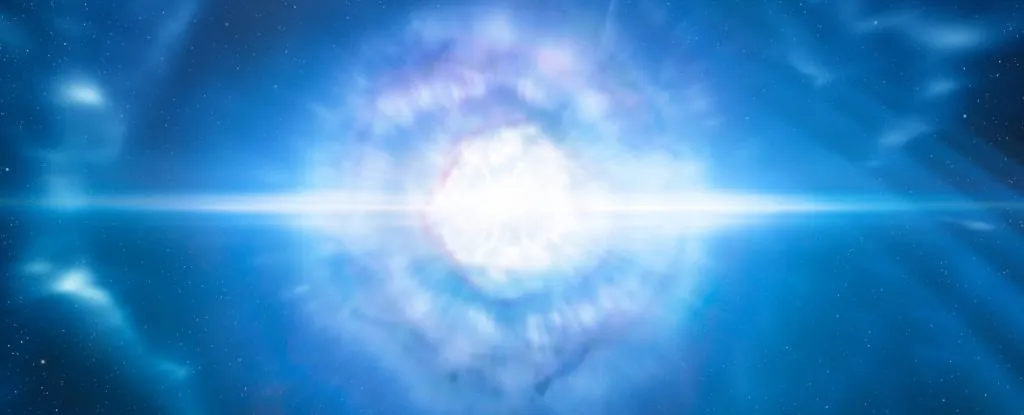
Astronomers Discover a Mind-Boggling Gamma-Ray Explosion That Shatters Our Understanding of Space!
2025-09-11
Author: Yu
A colossal explosion recently illuminated the skies and sent shockwaves through the cosmos, shattering scientists' comprehension of the universe's fiercest outbursts.
On July 2, 2025, a gamma-ray burst (GRB) was recorded—the longest ever observed, lasting an astonishing day! In comparison, these bursts typically flicker for mere milliseconds to minutes.
Even more astonishing, this particular GRB appears to have repeated itself—an enigma that current astrophysical models struggle to comprehend.
Astrophysicist Antonio Martin-Carrillo of University College Dublin exclaimed, "This event is unlike any other in 50 years of GRB observations! GRBs are catastrophic, one-time phenomena; this one baffled us by showing not just repeated powerful activity but also a strange periodicity, never seen before!"
GRBs are the universe's most explosive events, unleashing energy in mere seconds that surpasses the total output of our Sun over its lifetime.
There are two primary mechanisms believed to drive these violent eruptions: the core-collapse of a massive star that forms a black hole, resulting in long-duration bursts; and the collision of two neutron stars, which produces shorter bursts.
The excitement surrounding the new detection, dubbed GRB 250702B, was immediate. Detected by NASA's Fermi gamma-ray telescope, it transmitted alerts not once, but three times over several hours, pulsating with bursts of gamma rays.
Co-led by Martin-Carrillo and astrophysicist Andrew Levan from Radboud University, the research team rushed to decode this cosmic marvel.
After analyzing data from other telescopes, they found that the Einstein Probe, a space-based X-ray observatory, had picked up X-rays from the same source almost a full day before the Fermi observations.
Initially, astronomers thought this bright source might be located within our own Milky Way. However, when they aimed the Very Large Telescope and the Hubble Space Telescope at the location, they were stunned to discover otherwise.
The exact distance remains a mystery, but the galaxy that birthed this peculiar event is intriguingly odd, appearing split into two distinct regions—a tantalizing clue to the nature of the explosions.
Martin-Carrillo pondered, "If a massive star, about 40 times the mass of the Sun, had met a typical end, it must have undergone a unique demise that sustained some energy, or the periodic gamma-ray flashes could result from a star being obliterated by a black hole—a phenomenon known as a tidal disruption event (TDE)."
However, he notes, "To account for this explosion's characteristics, an unusual star likely faced destruction by an even rarer intermediate mass black hole. Either scenario would mark an astronomical first, making this event exceptionally unique!"
To uncover the secrets of GRB 250702B, astronomers must first calculate the distance to its galaxy. This measurement will help determine the burst's brightness, shedding light on the incredible energy it released and its origin.
Martin-Carrillo concluded, "We still don't fully understand this event, and whether we will ever have the answers, but this research represents a monumental leap toward grasping this extraordinary and thrilling phenomenon!"


 Brasil (PT)
Brasil (PT)
 Canada (EN)
Canada (EN)
 Chile (ES)
Chile (ES)
 Česko (CS)
Česko (CS)
 대한민국 (KO)
대한민국 (KO)
 España (ES)
España (ES)
 France (FR)
France (FR)
 Hong Kong (EN)
Hong Kong (EN)
 Italia (IT)
Italia (IT)
 日本 (JA)
日本 (JA)
 Magyarország (HU)
Magyarország (HU)
 Norge (NO)
Norge (NO)
 Polska (PL)
Polska (PL)
 Schweiz (DE)
Schweiz (DE)
 Singapore (EN)
Singapore (EN)
 Sverige (SV)
Sverige (SV)
 Suomi (FI)
Suomi (FI)
 Türkiye (TR)
Türkiye (TR)
 الإمارات العربية المتحدة (AR)
الإمارات العربية المتحدة (AR)